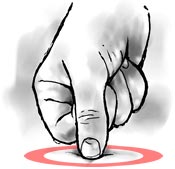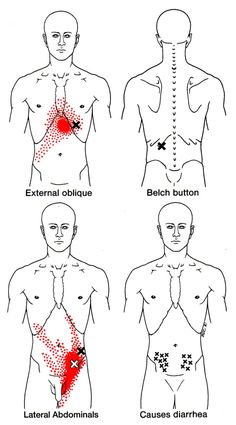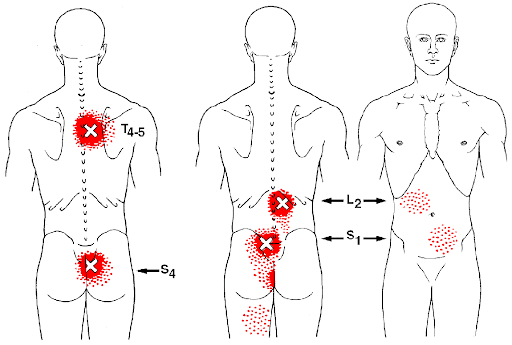What are Trigger Points?
Trigger points are not fully understood but they are essentially sore areas found by pressing your skin that covers muscles.
Trigger points are described as active or latent.
They can be created in many ways such as unaccustomed exercise, after a sudden stretch or jolt, due to prolonged postures at work or even after coughing, gastro, viruses, constipation, a response to the tension of stress or painful periods.
The trigger points can remain active even after the event has long past.
When it comes to the abdominal wall, active trigger points can be misinterpreted and feel exactly like ovary, uterus, bowel or bladder pain.
Also when real bladder, bowel or endometriosis problems are treated often the trigger points remain active and make abdominal pain continue.
What to do with trigger points
Trigger points are not permanent.
You can alter them in many ways in a temporary way.
- self trigger point therapy
- massage
- heat
- stretching
- exercise
- dry needling
It is super important then to understand why they return and address the driver behind them returning
This could be related to
- nearby muscle weakness
- prolonged positions you hold when you work, study or relax
- tight clothing
- the type of exercise you do
- thoughts and beliefs you have when experiencing pain
- cyclical cramping
- stressful triggers in your life
Self Trigger Point Therapy
By pressing on active trigger points and relaxing your body and focussing on your breathing you can reduce the trigger point discomfort and the referred pain.
It is important to know that sustained compression is what will help to alleviate the trigger point.
If you only hold for a short period of time, and don’t continue with the treatment, very little therapeutic benefit will be gained.
How Much Pressure is Enough?
We suggest holding the trigger point at a level of a 5/10 until you experience discomfort and perhaps a sensation familiar to you.
This will never cause tissue damage and is safe. Wait until the sensation starts to change and then decrease.
The deepest pressure should indent your abdomen skin to the first knuckle.
At which point you can either press harder in that area or move to another nearby location.
So, to review:
– Find the trigger point
– Hold pressure at a 5/10
– Wait for the tissue to release (you can feel it soften under your skin, or feel a decrease in the local or referred pain.)
– Once the tissue releases and the referral starts to dissipate, either go deeper into the tissue or move to another trigger point.

How often should I repeat the trigger point release?
The answer to this question will vary from person to person and there is no hard evidence to guide this yet.
As a guide try to do it daily for no more than 10 minutes.
Over the course of a week the time it takes for the trigger points to become comfortable reduces.
Once the trigger points have been deactivated your physiotherapist can suggest the next strategies which could be to stretch, strengthen or relax the muscles.
Trigger points are not (usually not) the only problem. They are usually part of a bigger problem that has to do with posture and exercise in your daily life.
External Oblique Muscles
The abdominal oblique muscles form the wall of the abdomen and help to move the trunk relative to the pelvis.
Contraction of these muscles, along with the other abdominal muscles, also acts to increase the pressure inside the abdominal cavity, which is necessary support your spine and organs.
The trigger points in these muscles are unique in that they not only produce sensations in the abdominal wall they often mimic organ dysfunction or disease.
Many times, these abdominal trigger points are created by the abdominal organs, and will persist long after the organ problem has resolved.
Additionally, these trigger points often refer pain to the testicles and genitalia.
Because these muscles are prone to overload from emotional stress, core body mechanics, prolonged postural holding and visceral dysfunction, they are frequently a hotbed of trigger point activity.
External Oblique Muscles Symptoms & Disorders
Clients with active oblique trigger points will present with any or all of the following symptoms or clinical findings:
Pain in the deep epigastric region, such as those symptoms associated with heartburn or hiatal hernia
Pain in the groin, testicles, bladder and lower abdominal region
Belching, stomach distention, diarrhea.

Rectus Abdominis Symptoms & Disorders
Clients with active rectus abdominis trigger points will present with any or all of the following symptoms or clinical findings:
Low Back Pain: bilateral pain along the hip crests and in the sacroiliac joints.
Mid Back Pain: bilateral pain across the mid back region, at the base of the rib cage.
Abdominal Pain: Pain around the xyphoid process in the epigastric region and pain the lower quadrants of the abdomen.
Gastrointestinal Symptoms: Abdominal pressure or discomfort, heartburn, nausea and vomiting, diarrhea, appendicitis-type pain, colic or diverticulitis, and gall bladder/gall stone-type pain
Gynecological Symptoms: painful menstruation and pain in the genitalia

Iliopsoas Symptoms and Disorders
Clients with active iliopsoas trigger points will present with any or all of the following
Low back pain that is worse in the standing position
Low back pain has a vertical distribution, and may or may not have a groin component.
Pain may be experienced during a bowel movement.

Quadratus Lumborum

Back Muscles

Hip muscles

Some hip muscles can also refer pain as abdominal pain or inside pain.
These are very easy to treat too.
Diaphragmatic Breathing
Diaphragmatic breathing is a cornerstone technique for managing your abdominal pain or any pain.
Click here for more information
Heat Packs
A covered hot water bottle or wheat bag placed over your abdomen can be really soothing.
It is great to do this in combination with diaphragmatic breathing.
Massager
Your physiotherapist might suggest you purchase or hire a hand held massager cushion.
Use a similar amount of pressureand no more.
Use a folded towel between the massager and your body to control the pressure.
As a rule start the massager on the trigger points that are most comfortable first.
Then slowly in another session work your way to the most active trigger point which refers pain to another location.
You might like to massage on either side of your spine as well whilst lying on your side on a couch and leaning slightly into the cushion to control the pressure.
Dry needling
Dry needling is a common therapy used by physiotherapists to make active or latent trigger points settle.
This can help in reducing the pain experienced from trigger points.
Your physiotherapist will tell you if they think dry needling is for you.
